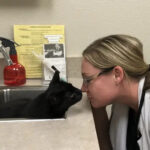Ever wondered if your purring pal is middle-aged in human years, or still just a sprightly teenager? It’s a common question for cat lovers! While cats age differently than humans, understanding the concept of “Cat Human Years” can provide valuable insights into your feline companion’s life stage and care needs.
Unraveling the Mystery of Cat Lifespans
The lifespan of a cat isn’t set in stone and varies based on several factors. Generally, indoor cats enjoy longer lives compared to their outdoor counterparts. An indoor cat typically lives between 16 to 18 years, with some even gracefully aging into their 20s. Outdoor cats, facing environmental hazards and risks, often have shorter lifespans, averaging around 13 to 14 years.
Breed also plays a role in longevity. Certain cat breeds are genetically predisposed to longer lives. For instance, Siamese and Manx cats are known for their potential to live longer, potentially reaching impressive ages when converted to human years.
Fascinating Fact: Did you know the oldest cat on record supposedly lived to the incredible age of 34? That’s an astonishing 153 years in human years!
Alt text: A tabby cat looking inquisitively at the camera, representing the question of cat years to human years conversion.
Thanks to advancements in veterinary care and safer living environments, cat lifespans have significantly increased over recent decades. This means we are fortunate to spend more quality time with our beloved feline family members.
The Cat Aging Process: A Different Timeline
Cats experience rapid aging during their first two years. After this initial phase, the aging process gradually slows down. Determining a cat’s age in human years involves observing physical and behavioral changes and aligning these stages with the human life cycle. This comparison helps us better grasp where our feline friend is in their journey of life.
Why Understanding Cat Age in Human Years Matters
Knowing your cat’s approximate age in human years is more than just a fun fact; it’s crucial for responsible pet ownership. Understanding their life stage allows you to anticipate and prepare for potential age-related health issues. Recognizing when your cat transitions into their mature or senior years empowers you to provide the most appropriate and supportive care. This might include adjusting their diet, providing more comfortable bedding, or being vigilant about age-related health screenings.
Detective Work: How to Estimate Your Cat’s Age
If your cat joined your family without a known kittenhood history, determining their age might seem like a puzzle. The most reliable approach is a visit to your veterinarian. Vets are skilled at estimating a cat’s age based on various physical indicators. They will assess tell-tale signs related to their teeth, fur, eyes, muscles, and bones to provide a well-informed age estimation, along with an overall health check.
However, you can also become a bit of a feline age detective yourself by observing some key characteristics:
Teeth: A Window to Age
While teeth can’t reveal the exact birthday, they offer valuable clues about a cat’s age progression. Here’s a tooth timeline:
- Kitten’s First Teeth: Tiny baby teeth emerge between 2 to 4 weeks of age.
- Permanent Teeth Arrival: Adult, white teeth replace baby teeth around 4 months old.
- Early Tartar Build-up: Yellowish tartar stains on a few teeth might indicate a cat is between 1 to 2 years old.
- Widespread Tartar: Tartar on all teeth suggests an age of at least 3 to 5 years.
- Missing Teeth Mystery: Missing teeth are often observed in senior cats, typically between 10 to 15 years and older.
Alt text: Close-up of a cat’s teeth, illustrating how dental condition can be an indicator of a cat’s age in the context of cat human years.
It’s important to remember that dental health can vary among cats regardless of age. Breed, diet, genetics, and overall health can influence teeth condition.
Beyond Teeth: Other Age Indicators
While teeth are a primary indicator, other physical attributes contribute to age estimation:
- Fur and Coat: Younger cats usually have soft, fine fur. As cats age, their coat might become thicker, coarser, and potentially include gray or white hairs, particularly around the face.
- Eyes: Bright, clear eyes are common in younger cats. Older cats might develop some cloudiness in their eyes. Iris color can also become less vibrant with age.
- Muscle Tone and Body Condition: Younger cats are typically more muscular and agile. Senior cats may experience some muscle loss and reduced activity levels. Their body condition might become thinner as they age.
By considering these multiple factors, you and your vet can piece together a more accurate estimate of your cat’s age in human years, ensuring they receive the best possible care throughout their life.

